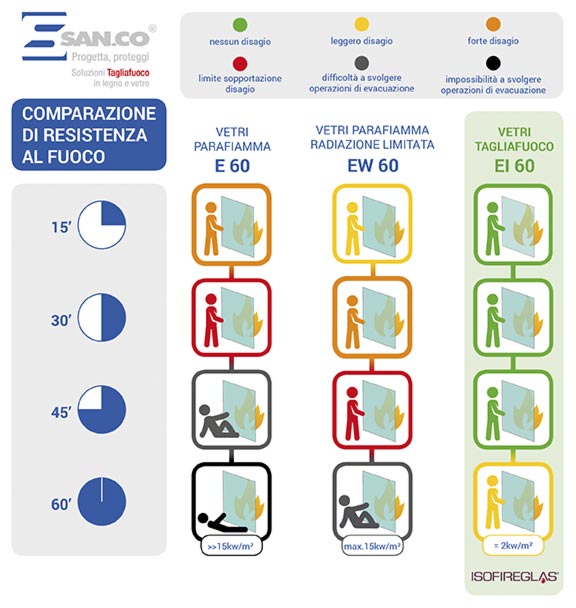
The “fire resistance” refers to the time during which, during a fire, a doors retains its physical and mechanical properties. The door is classified into two categories:
- E: tight gas and flame
- I: thermal insulation (necessarily used in addition to an E classification)
These letters are followed by two or three digits giving the resistance time in minutes. The European classication is complemented by category:
- W: energetics Limited Issue
(necessarily used in addition to an E classification)
STANDARDS OF REFERENCE
Fire resistance for doors, shutters and and openable window assemblies.
ITALIAN STANDARDS AND EUROPEAN STANDARDS FOR CE MARKING
From November 1st 2019 it is compulsory to CE Mark the fire resistant pedestrian doorsets for extriors according to EN 16034.
It is also compulsory to CE mark the industrial and garage doors, according to EN 16034 and EN 13241-1.
The fire doors of SanCo, therefore, can not yet be CE marked because of a regulatory deficiency that will be filled after the publication of EN 14351-2 in the European Official Journal: at that time the period of coexistence – during which it will be possible but not compulsory to CE mark the internal doors- and the DOW (Date Of Withdrawal) will also be established, that is the date of withdrawal of all the conflicting national standards; after the DOW, CE marking will be compulsory. At the moment the CEN has set this date at 31.08.2021
Since 2005 each new product has been designed, fire tested and certified according to the European standard, the first step towards a future CE marking. Each prototype is tested at the mouth of a furnace with at least nine burners that raises the internal temperature to over 900°C in just a few minutes. The fire resistance class (E, EW, EI1, EI2) expressed in minutes shows the time during which the door has ensured the parameters needed for classification. In the case of the highest class, EI1, the element tested has stopped the spread of the flames and its non-exposed side has not reached a temperature of more than 140°C.
San.Co has numerous validations from authorised institutes in other countries: authorisation is given to sell SanCo products on the local market on the basis of Italian test reports or directly through tests in foreign labs. Some of the best known laboratories having granted San.Co the above mentioned validations are Efectis in France, VKF in Switzerland and Bodycote Exova in the U.K.
CE marking will cancel all the local validation through the EU, it is also possible that many non EU countries will simply accept CE marked doors.
It is worth noting that a fire door can have the CE mark for different performance parameters, which are as follows:
• the fire resistance class (E, EW, EI1, EI2) expressed in minutes
• smoke sealing (Sm, Sa)
• and the durability of the self-closing system (from C0 to C5) expressed in number of cycles from 0 to 200,000
